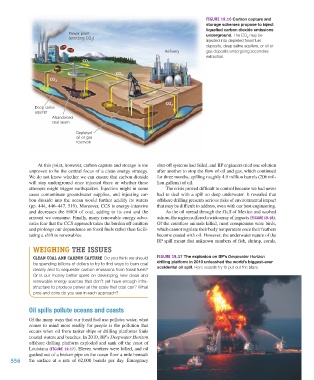Page 557 - Environment: The Science Behind the Stories
P. 557
FIGURE 19.16 Carbon capture and
storage schemes propose to inject
liquefied carbon dioxide emissions
Power plant underground. The CO may be
) 2
injected into depleted fossil fuel
(emitting CO 2
deposits, deep saline aquifers, or oil or
Refinery gas deposits undergoing secondary
extraction.
CO 2
CO 2
CO 2
CO 2
Deep saline
aquifer
Abandoned
coal seam
Depleted
oil or gas
reservoir
At this point, however, carbon capture and storage is too shut-off systems had failed, and BP engineers tried one solution
unproven to be the central focus of a clean energy strategy. after another to stop the flow of oil and gas, which continued
We do not know whether we can ensure that carbon dioxide for three months, spilling roughly 4.9 million barrels (206 mil-
will stay underground once injected there or whether these lion gallons) of oil.
attempts might trigger earthquakes. Injection might in some The crisis proved difficult to control because we had never
cases contaminate groundwater supplies, and injecting car- had to deal with a spill so deep underwater. It revealed that
bon dioxide into the ocean would further acidify its waters offshore drilling presents serious risks of environmental impact
(pp. 444, 446–447, 519). Moreover, CCS is energy-intensive that may be difficult to address, even with our best engineering.
and decreases the EROI of coal, adding to its cost and the As the oil spread through the Gulf of Mexico and washed
amount we consume. Finally, many renewable energy advo- ashore, the region suffered a wide array of impacts (FIGURE 19.18).
cates fear that the CCS approach takes the burden off emitters Of the countless animals killed, most conspicuous were birds,
and prolongs our dependence on fossil fuels rather than facili- which cannot regulate their body temperature once their feathers
tating a shift to renewables. become coated with oil. However, the underwater nature of the
BP spill meant that unknown numbers of fish, shrimp, corals,
WEIGHING THE ISSUES
CLEAN COAL AND CARBON CAPTURE Do you think we should FIGURE 19.17 The explosion on BP’s Deepwater Horizon
be spending billions of dollars to try to find ways to burn coal drilling platform in 2010 unleashed the world’s biggest-ever
cleanly and to sequester carbon emissions from fossil fuels? accidental oil spill. Here vessels try to put out the blaze.
Or is our money better spent on developing new clean and
renewable energy sources that don’t yet have enough infra-
structure to produce power at the scale that coal can? What
pros and cons do you see in each approach?
Oil spills pollute oceans and coasts
Of the many ways that our fossil fuel use pollutes water, what
comes to mind most readily for people is the pollution that
occurs when oil from tanker ships or drilling platforms fouls
coastal waters and beaches. In 2010, BP’s Deepwater Horizon
offshore drilling platform exploded and sank off the coast of
Louisiana (FIGURE 19.17). Eleven workers were killed, and oil
gushed out of a broken pipe on the ocean floor a mile beneath
556 the surface at a rate of 62,000 barrels per day. Emergency
M19_WITH7428_05_SE_C19.indd 556 12/12/14 5:23 PM

